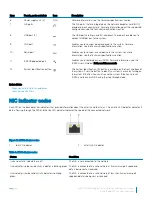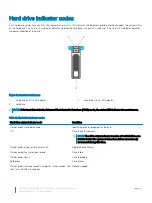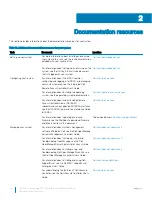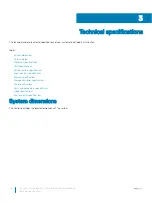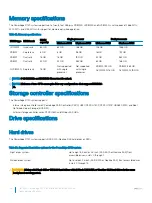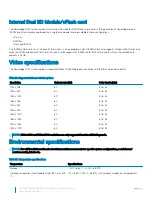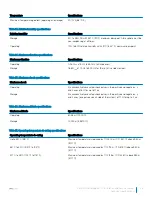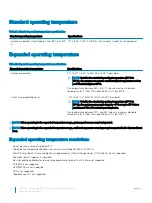
Power indicator codes
Condition
CAUTION:
AC PSUs support both 240 V and 120 V input voltages with the exception of Titanium
PSUs, which support only 240 V. When two identical PSUs receive different input voltages, they
can output different wattages, and trigger a mismatch.
CAUTION:
If two PSUs are used, they must be of the same type and have the same maximum
output power.
CAUTION:
Combining AC and DC PSUs is not supported and triggers a mismatch.
Figure 12. DC PSU status indicator
1
DC PSU status indicator
Table 11. DC PSU status indicator codes
Power indicator codes
Condition
Green
A valid power source is connected to the PSU and the PSU is operational.
Blinking amber
Indicates a problem with the PSU.
Not illuminated
Power is not connected to the PSU.
Blinking green
When hot-plugging a PSU, the PSU indicator blinks green. This indicates that there is a PSU mismatch
with respect to efficiency, feature set, health status, or supported voltage.
CAUTION:
If two PSUs are installed, both the PSUs must have the same type of label; for
example, Extended Power Performance (EPP) label. Mixing PSUs from previous generations
of PowerEdge servers is not supported, even if the PSUs have the same power rating. This
results in a PSU mismatch condition or failure to turn the system on.
CAUTION:
When correcting a PSU mismatch, replace only the PSU with the blinking
indicator. Swapping the PSU to make a matched pair can result in an error condition and
unexpected system shutdown. To change from a High Output configuration to a Low Output
configuration or vice versa, you must turn off the system.
CAUTION:
If two PSUs are used, they must be of the same type and have the same
maximum output power.
CAUTION:
Combining AC and DC PSUs is not supported and triggers a mismatch.
Dell EMC PowerEdge R740 Installation and Service Manual
PowerEdge R740 system overview
19













